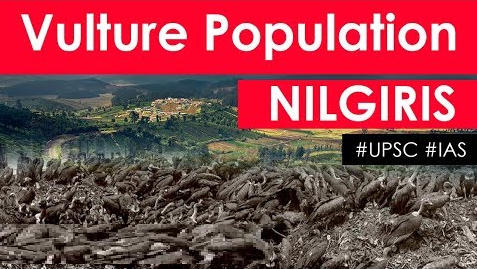Table of Contents
Context
- The population of vultures in the Nilgiris has increased by more than 26 % since 2012.
- However the major threats are still prevalent in the region.
Vultures in Nilgiri
- In 2012, the number of vultures seen in the Nilgiris was around 152
- Since then, the population increased each year till 2014
- It then recovered to 192 individuals in 2018.
- While these three species of vulture are known to nest almost exclusively in the Mudumalai and Sathyamangalam Tiger Reserves in Southern India, other vulture species, such as the Cinereous vulture, the Himalayan griffon vulture and Egyptian vulture have been spotted visiting the Nilgiris each year.
Threats
- Vulture populations across the Western Ghats, and the rest of India, plummeted in the 1990s
- The effects diclofenac and other antiinflammatory drugs
- This was done in subsequent workshops in the Nilgiris and Coimbatore in 2011 and 2015.
- Unlike in other landscapes in India with high vulture population, the use of antiinflammatory drugs like diclofenac, nimesulides and flunixin, was not as big a threat in the Nilgiris.
- Cattle were being sold to slaughterhouses, which meant that people had very little reason to use expensive drugs to try and keep the animals alive when they fell ill.
Resolution
- One of the major resolutions adopted was that the Department of Animal Husbandry would stop procuring non-steroidal antiinflammatory drugs
- This was to ensure that vultures did not die of scavenging carcasses that contained diclofenac residue.
India Released Vultures
- It was decided if there is no toxicityrelated death of these eight birds in two years, then 20-25 birds will be released every year.
- In a first, eight captive-reared critically endangered white-backed vultures will be released with tracking devices.
Vulture
- A vulture is a scavenging bird of prey. The two types of vultures are the New World vultures, including the Californian and Andean condors, and the Old World vultures, including the birds that are seen scavenging on carcasses of dead animals on African plains.
- Vultures are scavengers, meaning they eat dead animals. They rarely attack healthy animals, but may kill the wounded or sick.
Conservati on status
- Vultures in south Asia, mainly in India and Nepal, have declined dramatically since the early 1990s.It has been found that this decline was caused by residues of the veterinary drug Diclofenac in animal carcasses.
- The government of India has taken very late cognizance of this fact and has banned the drug for animals.
Indian vulture crisis
- Nine species of vulture can be found living in India, but most are now in danger of extinction
- The sudden collapse of the natural animal disposal system in India has had multiple consequences. The carcasses formerly eaten by vultures rot in village fields leading to contaminated drinking water. The disappearance of vultures has allowed other species such as rat and wild dog populations to grow.
Threatene d Wildlife
- India has about 8 percent of the world’s biodiversity on 2 percent of the earth’s surface, making it one of the 12 megadiversity countries in the world.
- Of about 1.75 million species globally identified, around 1,26,188 species have been reported so far from India. The species recorded include flowering plants (angiosperms), mammals, fish, birds, reptiles and amphibians, constituting about 17.3 percent of the total, whereas fungi and insects make up nearly 60 percent of India’s bio-wealth.
- This diversity can be attributed to the great variety of natural ecosystems due to the varied physical and climatic features found in India.
Legislation for Protecting Endangered Species
- The Convention on International Trade in Endangered Species of Wild Fauna and Flora (CITES), 1973, is a significant step in this direction.
- The United Nations Convention on Biological Diversity 1992 is another milestone.
- The Wildlife (Protection) Act, 1972, is our national initiative to protect wildlife.
- The Biological Diversity Bill, 2000, which is in the offing, also interalia, strives to protect and conserve the biodiversity and endangered species in India.
Latest Burning Issues | Free PDF

























 WhatsApp
WhatsApp